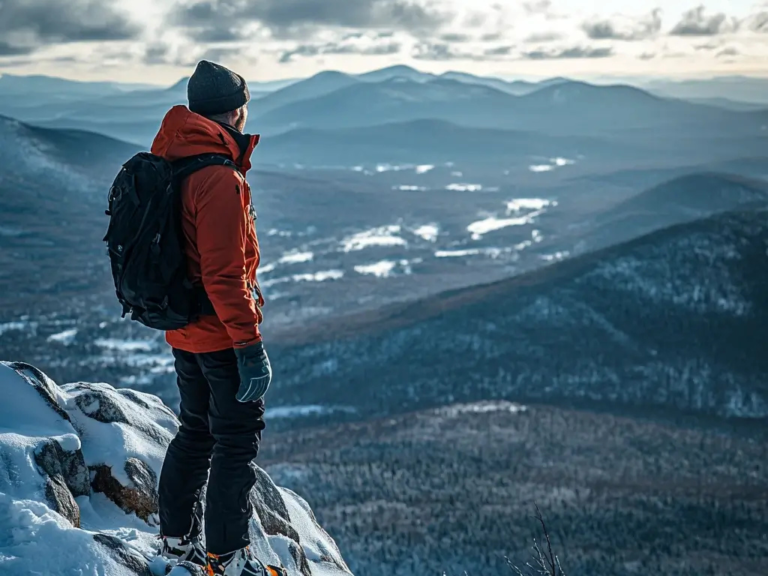As winter approaches, we can’t help but feel the thrill of exploring snow-covered mountains. Choosing the right hiking outfit winter mountain adventures is essential for staying warm and safe on the trails. With the right gear, we can embrace the cold and enjoy the breathtaking beauty of winter landscapes.
Layering is key to our comfort, allowing us to adjust to varying temperatures as we hike. From moisture-wicking base layers to insulated mid-layers and waterproof outer shells, every piece plays a vital role in our hiking experience. Let’s jump into the essentials that will make our winter hikes enjoyable and safe without sacrificing style.
Whether it’s our cozy wool socks or durable waterproof pants, we’ll cover the must-have items for every winter hiking outfit. Get ready to explore the great outdoors in comfort while tackling the snowy terrain head-on!

Essential Elements of a Hiking Outfit Winter Mountain
When preparing for winter mountain hikes, choosing the right outfit is crucial. We need to focus on layering effectively to stay warm, dry, and comfortable in various conditions. Each layer plays a vital role in our overall comfort and performance.
Thermal Base Layers
The foundation of our winter hiking outfit starts with thermal base layers. These layers help to wick moisture away from our skin, keeping us dry. We should look for materials like merino wool or synthetic fibers that provide insulation without bulk.
A good base layer will fit snugly against the body to trap heat. It’s essential to avoid cotton as it retains moisture, which can lead to chills. We recommend long-sleeve tops and long johns for full coverage.
Insulating Mid-Layers
Next, we have insulating mid-layers that offer additional warmth. Fleece and down jackets are popular choices as they provide excellent insulation. When selecting this layer, we should ensure it allows freedom of movement.
Opt for zippered styles so we can easily adjust ventilation during our hike. A versatile mid-layer can also be worn alone during less chilly conditions. It’s essential to balance warmth with breathability to prevent overheating.
Waterproof Outer Layers
Finally, our waterproof outer layers are vital in protecting us from the elements. A quality shell jacket and pants will keep wind and moisture at bay. Look for materials that offer breathability, such as Gore-Tex or similar fabrics.
Sealed seams and adjustable hoods are significant features to enhance protection. Layering this outer shell over our mid-layers allows us to adapt to changing weather conditions. Always test the fit to ensure we can accommodate our layers comfortably.

Footwear for Safe Trekking in Snowy Terrain
When hiking in winter mountain conditions, having the right footwear is crucial for our safety and comfort. Proper insulated hiking boots and reliable traction aids make all the difference as we navigate snowy and icy trails.
Insulated Hiking Boots
Choosing the right insulated hiking boots is essential for warmth and protection. We should look for boots that are waterproof, with features like GORE-TEX or similar materials to keep our feet dry.
Insulation Types
- Thinsulate: Commonly found with ratings between 200g to 400g.
- Synthetic Fill: Provides moisture resistance and warmth.
Ensure a snug fit, allowing enough room for our toes to move. This helps maintain circulation and keeps our feet warm. Opt for boots with a sturdy sole for cushioning and support.
Some popular choices include the Newton Ridge Plus Waterproof Amped that provides excellent insulation and support.
Traction Aids
To navigate slippery trails, traction aids like crampons or microspikes are invaluable. These devices enhance grip on icy and snowy surfaces, reducing the risk of falls.
Types of Traction Aids
- Crampons: Best for steep, icy terrain. They typically attach to our boots.
- Microspikes: Ideal for less extreme conditions while providing excellent grip.
When selecting traction aids, we should ensure they fit our boots securely. It’s also helpful to practice walking with these aids on flat terrain before hitting the trails, ensuring we are comfortable and confident.

Accessorizing for Warmth and Efficiency
When we head out for winter mountain hikes, the right accessories can significantly enhance our comfort and performance. Focusing on critical items that protect our extremities and provide extra insulation is essential for an enjoyable experience.
Gloves and Mittens
Choosing between gloves and mittens can impact our warmth and dexterity. Gloves are great for maintaining mobility, allowing us to grip tools and trekking poles easily. However, mittens often provide more warmth by keeping our fingers together, helping retain heat.
We recommend insulated, waterproof materials to keep our hands dry and warm. Look for gloves with adjustable cuffs to prevent snow from entering. Some options even offer touchscreen compatibility, allowing us to use our devices without freezing our fingers.
Key features to consider:
- Insulation: Look for Thinsulate or down fill.
- Waterproofing: Essential for wet and snowy conditions.
- Cuff Style: Longer cuffs provide extra coverage.
Beanies and Balaclavas
Keeping our head and neck warm is vital for our overall body temperature. A well-fitted beanie can trap heat, while a balaclava provides additional coverage for our face and neck.
Opt for materials like merino wool or synthetic fleece. These fabrics offer warmth without bulk and wick moisture effectively. A beanie should fit snugly to prevent cold air from sneaking in, and a balaclava can be pulled down when not needed.
Consider these features:
- Fit: Ensure a snug yet comfortable fit.
- Breathability: Look for fabrics that allow heat to escape while keeping warmth in.
- Versatility: Some balaclavas can be worn in multiple styles for added convenience.
Socks and Gaiters
Quality socks play a major role in our winter hiking outfit. Thick, moisture-wicking socks help keep our feet dry and warm, reducing the risk of blisters. Wool blends are an excellent option as they provide insulation and moisture management.
Gaiters are another accessory we should consider. They protect our socks and pants from snow, mud, and debris. They also add an extra layer of insulation around our calves.
Key features to watch for include:
- Cushioning: Look for padded socks for comfort.
- Height: Gaiters come in various heights to suit our needs.
- Fastening: Ensure easy accessibility but a secure fit.
By carefully selecting these accessories, we can ensure that our hiking outfit for the winter mountain is well-rounded, keeping us warm and efficient on the trail.
Meta description: Discover essential tips for selecting the perfect hiking outfit winter mountain for your next adventure!

Navigating the Cold: Tools and Technology
When hiking in cold conditions, effective navigation tools and emergency communication devices are essential for safety and peace of mind. Let’s explore how to stay on course and connected.
GPS and Mapping Tools
For cold-weather hiking, reliable GPS devices are invaluable. The Garmin GPSMAP 66i stands out for its robust features, including satellite communication capabilities. This ensures we can navigate effectively, even in areas with limited service.
We should always carry traditional maps and compasses as backups. Familiarizing ourselves with these tools beforehand can be a lifesaver if our technology fails. Utilizing apps on our smartphones can also enhance our navigation experience. Offline maps allow us to track our progress without needing a signal.
Key features to consider for GPS devices:
- Battery life
- Weather resistance
- Ease of use
- Satellite communication
Emergency Communication Devices
Staying connected is crucial in emergencies. Devices like satellite messengers or personal locator beacons (PLBs) can send SOS signals to rescue teams when needed. These tools operate anywhere, giving us an added layer of safety.
In addition, a fully charged mobile phone can be helpful for quick communication. However, we must also prepare for battery drain due to cold temperatures. Keeping it in an insulated pocket can help conserve battery life.
Devices to consider:
- Satellite messengers (e.g., Garmin inReach)
- Personal locator beacons
- Fully charged mobile phone
Equipping ourselves with the right technology prepares us for the unexpected on our winter adventures.

Pack Essentials for Hiking Outfit Winter Mountain
When heading out for a winter mountain hike, staying prepared is essential. We need to ensure we have the right gear to keep us safe, comfortable, and energized throughout our adventure.
Hydration and Nutrition
Keeping hydrated in winter is crucial, as we might not feel as thirsty, but our bodies still lose moisture. We should pack a well-insulated water bottle or hydration system to prevent freezing. Additionally, consider using a hydration bladder with a tube that has a cover to avoid ice.
For nutrition, packing high-energy snacks is key. Options like trail mix, energy bars, and beef jerky are great on-the-go choices. We can also bring a lightweight, insulated thermos with a warm drink to enjoy during breaks. This not only provides warmth but also helps maintain energy levels. Remember, healthy snacks will keep us fueled and ready for whatever the mountain throws our way!
First-Aid and Survival Gear
A robust first-aid kit is non-negotiable. Our kit should include essentials like adhesive bandages, antiseptic wipes, and pain relievers. We might also want to include specific items like blister treatments due to the nature of winter hiking.
In addition to our first-aid supplies, having survival gear is vital. A space blanket, whistle, and a fire starter are essential pieces. We can even pack a multi-tool or knife for various needs. If we find ourselves in unexpected situations, this gear could be lifesaving. Preparing for the elements ensures we’re ready for a successful hike!

Our Experience with hiking outfit winter mountain
Hiking in the mountains during winter has always been one of my favorite adventures, but it requires careful planning, especially when it comes to choosing the right outfit. Over the years, I’ve learned that staying warm, dry, and comfortable is essential for enjoying the breathtaking beauty of snow-covered peaks and icy trails. My go-to winter mountain hiking outfit includes a thermal base layer, an insulating fleece, and a waterproof jacket that protects against wind and snow. I also rely on insulated hiking boots with strong traction to navigate slippery paths safely.
Accessories have become a game-changer in my experience. A good pair of gloves, a beanie, and a scarf or neck gaiter make a huge difference in keeping extremities warm, while moisture-wicking socks ensure my feet stay dry even during challenging treks. On one hike, I underestimated the weather and skipped a proper outer layer, leaving me chilled and uncomfortable—a mistake I never repeated.
Through trial and error, I’ve found that combining functionality with a touch of personal style makes winter mountain hiking even more enjoyable. From bold jackets to cozy scarves, the right gear not only enhances comfort but also makes those post-hike photos memorable. Every winter hike reminds me why preparation is key for an unforgettable adventure.

Our Tips for Hiking Outfit Winter Mountain
1. Layer Effectively: Start with a moisture-wicking base layer, add an insulating mid-layer like fleece, and finish with a waterproof and windproof outer shell to stay warm and adaptable.
2. Choose Insulated Footwear: Wear waterproof, insulated hiking boots with good traction to keep your feet warm and secure on icy or snowy trails.
3. Invest in Thermal Accessories: Pack a beanie, insulated gloves, and a neck gaiter or scarf to protect extremities from the cold and wind.
4. Opt for Breathable Fabrics: Choose materials like merino wool or synthetics that wick moisture and dry quickly, keeping you warm and dry throughout the hike.
5. Pack Extra Layers: Always carry an additional insulating layer or puffer jacket in your backpack in case temperatures drop unexpectedly.
6. Use Gaiters for Snow Protection: Gaiters can help keep snow out of your boots and pants, ensuring dry and comfortable feet.
7. Wear Warm Socks: Thick wool socks or synthetic thermal socks provide insulation and prevent blisters in cold conditions.
8. Carry a Waterproof Backpack: Use a durable, waterproof pack to store your extra layers, snacks, and essentials without them getting wet.
9. Add Reflective or Bright Colors: Wear bright or reflective clothing for better visibility in snowy or foggy conditions.
10. Test Your Gear Beforehand: Ensure all your clothing and accessories fit well and function properly before heading out into the mountains.

FAQ – Hiking Outfit Winter Mountain
What to wear when hiking in the winter?
Wear layers to stay warm and adaptable: a moisture-wicking base layer, an insulating middle layer like fleece, and a waterproof outer layer. Add insulated gloves, a hat, warm socks, and waterproof hiking boots for complete protection against the cold.
How cold is too cold for winter hiking?
Winter hiking becomes too cold when temperatures drop below your comfort level, usually around -20°F (-29°C) or lower, depending on your gear and experience. Wind chill, inadequate clothing, or lack of preparedness can make conditions unsafe even at milder temperatures.
What should I wear hiking in 40-degree weather?
In 40-degree weather, wear a moisture-wicking base layer, a lightweight insulating layer like fleece, and a wind-resistant outer shell. Add gloves, a hat, and warm socks to stay comfortable, especially if it’s windy or damp.
What is the best fabric for hiking in cold weather?
The best fabrics for cold-weather hiking are synthetic materials like polyester and nylon or natural materials like merino wool. These fabrics wick moisture, provide insulation, and dry quickly, keeping you warm and comfortable. Avoid cotton as it retains moisture and can make you colder.
If you liked this blog post about the topic Hiking Outfit Winter Mountain, don’t forget to leave us a comment down below to tell us about your experience with it.
If you found this post helpful, you might also enjoy our article on Ultimate Cute Hiking Outfit Winter for more tips on gearing up for your next cold-weather adventure!




